Chapter Nine—
Popular Manuscripts and the Religion Royale
While Charles V's and Charles VI's lavish manuscripts were garnering a limited courtly following, less costly copies of the Grandes Chroniques were being produced by booksellers for the growing Parisian book trade. First owners are known with certainty for only two surviving manuscripts: one book (Ste.-Gen. 783) belonged to Regnault d'Angennes, the chamberlain of the dauphin, Louis of Guyenne; and a second (B.N. fr. 6466–67) was presented to John of Berry by Jean de la Barre, the receiver general of finance in Languedoc and the duchy of Guyenne.[1] If these are representative owners, then they did not differ radically from the owners of manuscripts that copied royal models.
Illustrations in manuscripts produced for the book trade are independent of royal models and of one another. Perhaps because the royal library was out of bounds for the average Parisian bookseller, each editor seems to have developed new solutions to the problem of illustrating the Grandes Chroniques . Yet these manuscripts do have some elements in common. They have shorter cycles of decoration, which average between 30 and 50 miniatures and often have a looser relationship to their text than the cycles in royal manuscripts or those based on royal models. Miniatures in these cycles almost always mark the beginning of a king's reign and frequently illustrate a vivid story from one of the chapters. For instance, the beginning of the fifth book of the chronicle is illustrated in two iconographical groups by a picture of King Dagobert supervising the construction of the abbey of Saint-Denis, an event recounted in the ninth chapter. In some groups miniatures have little textual basis; in others they are based on erroneous readings of the text. For instance, certain copies of the Grandes Chroniques transform the Empress Richilda, who presented a sword and scepter to Louis the Stammerer, into an emperor.[2]
A comparison of three versions of the Grandes Chroniques —Valenciennes, B.M. 637, W. 138, and B.N. fr. 2604—offers a rare glimpse into the activities of the Parisian book trade at the end of the fourteenth and the beginning of the fifteenth century, when Charles's illness had been recognized but an overt political struggle had not yet developed.[3] These books, whose earliest owners are unknown, include a version of the chronicle that is related to Thomas of Maubeuge's early fourteenth-century manuscript, but they also provide a fully rubricated continuation to the accession of Charles VI in a version that had become
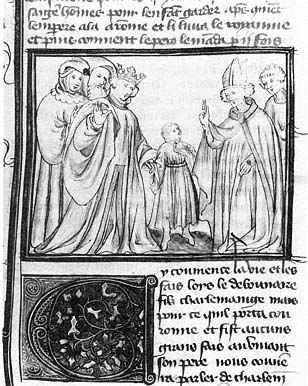
Figure 94
Charlemagne presents Louis the Pious to a bishop.
Grandes Chroniques de France . Valenciennes,
Bibliothèque Municipale, Ms. 637, fol. 134.
Photograph: Bibliothèque Municipale, Valenciennes.
standard by the late fourteenth century. Furthermore, they share unconventional iconography whose subjects are described in notes to the illuminator preserved in the margins of the manuscript from Valenciennes.[4]
A comparison of individual pictures not derived from their texts demonstrates the close relationship between the three cycles and these directions to the illuminator. For example, the Valenciennes miniature illustrating the life of Louis VII portrays a scene of homage that is never described in the life of that king but nonetheless appears in identical form in the book from Paris. Similarly, a peculiar illustration from the third book of Philip Augustus's life, which may illustrate the pope ordering Amaury de Bene to cease his heretical preaching, appears only in these three copies of the Grandes Chroniques .[5]
Even the textually based pictures in these manuscripts are nearly identical. For instance, the picture introducing the life of Louis the Pious in the manuscripts from Valenciennes and Paris (Figs. 94 and 95) follows the directions recorded in the margins of the former manuscript: "How the king, accompanied by two nobles directly behind him, holds his young son by the hand and presents him to two bishops and the first [bishop] blesses him and behind him [the bishop]
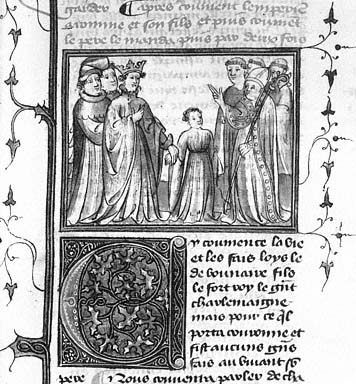
Figure 95
Charlemagne presents Louis the Pious to a bishop. Grandes
Chroniques de France . Bibliothèque Nationale, Ms. fr. 2604, fol.
145. Photograph: Bibliothèque Nationale, Paris.
is a chaplain."[6] Furthermore, all three manuscripts have identical scenes for the first book of the life of Philip Augustus (Figs. 96 and 97), an image that was also described precisely by the marginal note: "An armed king without a helmet sits on a bench; many armed men with shields behind; right in front are three kneeling and bareheaded men who present swords by their points and cry for mercy."[7]
The iconographical relationship between the three manuscripts is unquestionable, but the reason for the relationship is not totally clear. For instance, not every illustration in the three chronicles is based upon the Valenciennes notes; in the Valenciennes chronicle itself, 4 of 25 miniatures have no marginal directions; and in the Paris and Baltimore manuscripts 12 of 31 and 5 of 12 pictures, respectively, are independent of the directions preserved in the Valenciennes book.[8]
Indeed, even scenes that derive unquestionably from the directions differ in detail from one book to another. This fact clearly rules out the possibility that one book copied another and suggests instead that each responded independently to similar instructions. For example, in the Valenciennes and Paris manuscripts the illustration to Book III of the life of Charlemagne follows a direction that states: "How the king is in front and several nobles before him, and before him
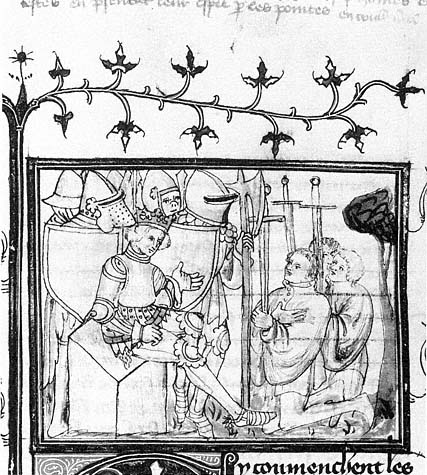
Figure 96
Surrender of Le Mans or Tours. Grandes Chroniques de France . Valenciennes,
Bibliothèque Municipale, Ms. 637, fol. 237v.
Photograph: Bibliothèque Municipale, Valenciennes.
[is] a castle and little men who construct around [it] and one is on a ladder and another low [on the ground] who cuts stone."[9] The Valenciennes miniature (fol. 111) represents Charlemagne, the nobles, the castle, and two masons, but omits the ladder. The Paris miniature (fol. 118) includes nobles, the castle with two masons, and a ladder, but omits Charlemagne. Both artists were confronted with the problem of selecting elements from the written direction that would fit within the limited space of the miniature; the Valenciennes artist chose to concentrate on Charlemagne as he commissioned the castle and thus cut back on the scene of construction, whereas the Paris artist focused on the details of construction and therefore had no room for Charlemagne.
Because seven different artists worked on these three cycles, it is unlikely that they are based on shared visual models preserved in artists' workshops. Only two
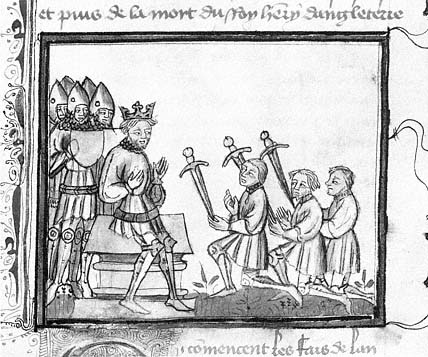
Figure 97
Surrender of Le Mans or Tours. Grandes Chroniques de France . Walters Art
Gallery, W. 138, fol. 15. Photograph: Walters Art Gallery, Baltimore.
artists worked on more than one book; an artist (W. 138, Artist I) who painted four miniatures in the Baltimore chronicle painted one in the Valenciennes book (Valenciennes, Artist IV), and the artist (Valenciennes, Artist I) who painted 21 images in the Valenciennes manuscript is close if not identical to the painter (B.N. fr. 2604, Artist III) of 26 pictures in the chronicle in Paris. Each of the other five artists worked on one of the three manuscripts: two worked on the chronicle in Valenciennes (Valenciennes, Artists II and III), two on the chronicle in Paris (B.N. fr. 2604, Artists I and II), and one on the chronicle in Baltimore (W. 138, Artist II). With one exception (Valenciennes, B.M. 637, fol. 154, completed by Valenciennes, Artist III), these artists worked in separate gatherings, so it is quite unlikely that they saw one another's work. The similarities in the iconographical programs of the Grandes Chroniques in Valenciennes, Baltimore, and Paris are therefore better interpreted as productions supervised by the same libraire than as productions by artists working in the same workshop. Apparently the libraire who supervised these manuscripts maintained a master list of directions to Grandes Chroniques illuminators, part of which survives in the margins of the Valenciennes manuscript.
This libraire seems to have tailored his repertoire to the needs of his patrons. Individual images from these books may be identical, but their cycles are not. The manuscript in Baltimore, a fragment containing the second half of the chronicle,
contains miniatures at the beginning of each book that are as wide as a single column of text. The chronicle in Paris is complete, and its cycle follows a standard pattern with a four-part frontispiece and a single picture at major book divisions. The only deviation occurs within the first book of the chronicle, where a double miniature marks the chapter describing Clovis's baptism. The Grandes Chroniques in Valenciennes is the most elaborate cycle of this group. Its decoration includes two four-part miniatures and a two-column-wide miniature of early Merovingian rulers; it omits several miniatures from the reigns of the last Capetians that appear in the other two chronicles. The pattern of addition and omission in the Valenciennes chronicle places special emphasis on the lives of the early Merovingians and singles out Clovis, the first Christian king of France.
Although this unusual emphasis on Merovingian kings is difficult to explain, the emphasis on Clovis can be understood as a manifestation of the religion royale .[10] Exceptional miniatures in the manuscripts in Paris and Valenciennes illustrate events from Clovis's life. A double picture in the Grandes Chroniques in Paris shows Clovis's battle with the Alemanni and his baptism by Saint Remi (fol.
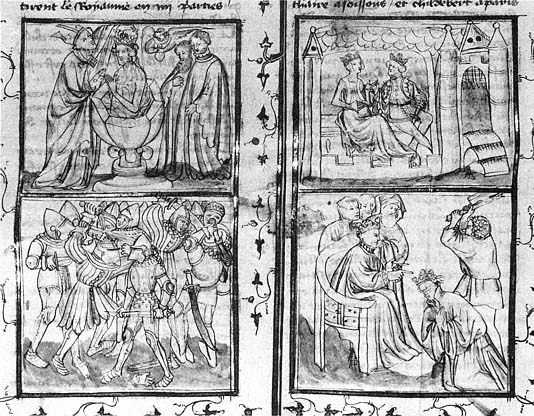
Figure 98
Baptism of Clovis; Clovis and Clotilda enthroned in the palace; Battle; Clodomir supervises the
execution of Sigismund, King of Burgundy(?). Grandes Chroniques de France . Valenciennes,
Bibliothèque Municipale, Ms. 637, fol. 14v. Photograph: Bibliothèque Municipale, Valenciennes.
12v). Clovis is even more important in the book in Valenciennes; there the battle and baptism scenes are separated from their texts and combined to form a second frontispiece with pictures of Clovis and Clotilda enthroned and of Clovis's son, King Clodomir, supervising the execution of King Sigismund of Burgundy (Fig. 98). This new frontispiece to Book II of the Grandes Chroniques blends narratives from Book I and Book II to present an image of the founding and early years of the Christian kingdom of France. It thus constitutes a visual counterpart to the traditional frontispiece in the manuscript, showing the founding of France by Trojan refugees and the early years of the pagan kings of France (Fig. 99).[11]
Clovis's status in the Paris and Valenciennes manuscripts reveals the strength and broad appeal of the religion royale at the turn of the century and emphasizes the importance of Clovis to its dissemination. Although Clovis had been revered as the model of a warrior king as early as 1300, he was more renowned as a model of good and just kingship and as a saint by the late fourteenth century. With the active encouragement of Charles V, Clovis's cult began to flourish. It was most popular during the reign of Charles V's grandson, Charles VII. Histories, poems,
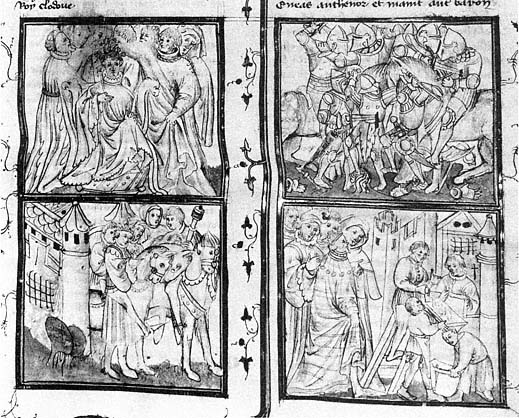
Figure 99
Coronation of Pharamond; Battle between French and Romans; King leaves city in formal
procession; King supervises the construction of Sicambria. Grandes Chroniques de France .
Valenciennes, Bibliothèque Municipale, Ms. 637, fol. 2.
Photograph: Bibliothèque Municipale, Valenciennes.
and sermons written in the late fourteenth and early fifteenth centuries promoted the first Christian king, the prototype of the rex christianissimus , as an intercessor.[12] Clovis's universal appeal is one reason that such images decorate the copies of the Grandes Chroniques at Valenciennes and Paris.
Besides embodying popular royalist sentiment, Clovis's prominence in the Valenciennes chronicle demonstrates the lack of dynastic focus in the popular versions of the Grandes Chroniques , perhaps the central difference between the illustrations of royal and popular copies of the text. Beginning in the reign of Charles V, pictures in royal copies of the chronicle most frequently stressed the lives of Charlemagne and Louis IX, two saints from whom the Valois proudly claimed descent. Clovis and other Merovingian kings were rarely featured in the dynastic programs of royal manuscripts of the Grandes Chroniques or, for that matter, in arguments asserting the legitimacy of the Valois line. For instance, when dynastic arguments are marshaled in Le songe du vergier to prove that France was established "according to God and the Holy Scriptures," the account begins with Pepin. Although the Songe mentions the holy unction, it attempts to prove legitimacy by the sanctity of the Valois kings' Carolingian and Capetian ancestors; thus it omits Clovis.[13]
For the Valois kings of the late fourteenth century, Clovis's significance lay predominantly in the fact that the holy unction, which first appeared at his baptism and which signaled divine sanction for his reign, was used at the coronations of later French kings, including the Valois monarchs. Thus in royal texts written at the time of Charles V references to Clovis are confined almost exclusively to discussions of the sacred symbols of French monarchy, as for instance in the preface to the translation of Augustine's City of God or in Jean Golein's Traité du sacre .[14]
Conversely, such popular commissions as the Grandes Chroniques in Valenciennes sought to glorify French kingship rather than justify Valois legitimacy. As a result, they broke from the royal dynastic tradition and focused special pictorial attention on Clovis as the first of the long line of Christian kings of France.
Image not available
Plate 1
Coronation of Pharamond. Grandes Chroniques de France . British
Library, Royal 16 G VI, fol. 3. By permission of the British Library.
Image not available
Plate 2
Pagan and Christian kings of France. Grandes Chroniques de France . Bibliothèque
Royale, Ms. 5, fol. 1. Copyright Bibliothèque Royale Albert Ier, Brussels.
Image not available
Plate 3
Battle of Courtrai. Grandes Chroniques de France . Castres, Bibliothèque
Municipale, fol 353v. Photograph: Bibliothèque Municipale, Castres.
Image not available
Plate 4
Peers support the crowns of Charles V and Jeanne of Bourbon. Grandes Chroniques de
France . Bibliothèque Nationale, Ms. fr. 2813, fol. 439. Photograph: Bibliothèque Nationale, Paris.
Image not available
Plate 5
Peers support the crown of Charles V. Coronation Book . British Library,
Cotton Tiberius B VIII, fol. 59v. By permission of the British Library.
Image not available
Plate 6
Peers support the crown of Jeanne of Bourbon. Coronation Book . British
Library, Cotton Tiberius B VIII, fol. 70. By permission of the British Library.
Image not available
Plate 7
Trojan fugitives at sea (Helenos, Aeneas, and Antenor?); Presentation of book to Charles
VI. Grandes Chroniques de France . Pierpont Morgan Library, M. 536, fol. 2. ©The Pierpont
Morgan Library 1991.
Image not available
Plate 8
Abduction of Helen; Punishment of Troy; Flight of the Trojans; Presentation
of book to Charles VI. Grandes Chroniques de France . Berlin, Deutsche Staatsbibliotek,
Phill. 1917, fol. 1. Photograph: Deutsche Staatsbibliotek Berlin.